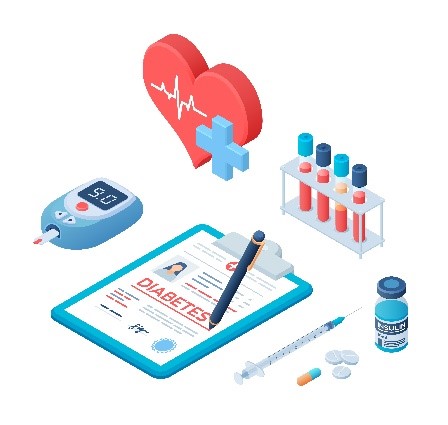Participation is Lacking in Follow-Through Programs
Diabetes is the leading cause of kidney failure and new cases of blindness among adults in the U.S.1 It is also associated with increased risks of cardiovascular disease, nonalcoholic fatty liver disease and was estimated to be the seventh leading cause of death in the U.S. in 2017. An estimated 13% of all U.S. adults (18 years or older) have diabetes, and 34.5% meet criteria for prediabetes (indicators that put an individual at risk of diabetes). But it’s not just a U.S. problem.

The World Health Organization reports that the number of people with diabetes rose from 108 million in 1980 to 422 million in 2014, 2 and prevalence has been rising more rapidly in low- and middle-income countries than in high-income countries. In 2014, 8.5% of adults aged 18 years and older had diabetes. In 2019, diabetes was the direct cause of 1.5 million deaths, and 48% of all deaths due to diabetes occurred before the age of 70 years, according to WHO. By contrast, the probability of dying from any one of the four main noncommunicable diseases (cardiovascular diseases, cancer, chronic respiratory diseases or diabetes) between the ages of 30 and 70 decreased by 18% globally between 2000 and 2016.
Despite what is known about diabetes, what is unknown may be worse. Many people who have prediabetes or diabetes are unaware of the fact. The U.S. Centers for Disease Control and Prevention reported that of persons with diabetes, 21.4% were not aware of or did not report having diabetes, and only 15.3% of persons with prediabetes reported being told by a health professional that they had this condition.1 This even though screening asymptomatic adults for prediabetes and type 2 diabetes may allow earlier detection, diagnosis, and treatment, with the ultimate goal of improving health outcomes.
That’s what prompted the U.S. Preventive Services Task Force to broaden its recommendations for screening in August 2021. USPSTF now recommends that adults aged 35 to 70 years who have overweight, or obesity be screened for prediabetes and type 2 diabetes.1 Just as important, the Task Force recommends that those with prediabetes be referred to an effective preventive intervention.
Follow-Through is Important!
Given increasing life expectancy after diagnosis and potentially increasing multimorbidity, the challenges of screening may be less formidable than the challenges and benefits of successfully providing long-term glycemic control and sustaining cardiovascular risk factor management among populations with diabetes.3 But delivering effective preventive interventions for people with prediabetes represents an ongoing missed opportunity.
In the 2016-2017 National Health Interview Survey of 50,912 adults, only 5% diagnosed with prediabetes reported referral to a diabetes prevention program or weight loss program.3 Of these, 40% reported participation. Multicomponent lifestyle interventions in the United States and the United Kingdom have shown encouraging program attendance and weight loss when referral occurs and programs are available. But U.S. enrollment represents less than 1% of the eligible population.
Young people have much to gain from follow-up to screening, and much to lose without it. Similar to that for young adults in many other parts of the world, the burden of diabetes among U.S. young adults has been increasing.4 The age divide points toward the millennial generation (those born roughly between 1980 and 2000) and their high obesity prevalence (approximately 35% with body mass index >30, calculated as weight in kilograms divided by height in meters squared), compounded by higher levels of smoking and poorer blood pressure and lipid level management.5 These factors may be combining with chronic kidney disease to influence an earlier onset of macrovascular complications.
Yet in 2018, according to the Behavioral Risk Factor Surveillance System in the U.S., only 44% in this age group reported being screened in the past three years, and they also were less likely to be referred for -- or undertake -- prevention services.3
Who’s to Blame?
In one study, healthcare professionals were two to three times more likely to give general physical activity or dietary advice to patients than refer them to formal intervention programs.6 Even among respondents with elevated BMI and diagnosed prediabetes, general advice about diabetes risk reduction was far more common (approximately 60%) than referral to a weight loss program (approximately 20%) or a diabetes prevention program (approximately 5%).
Why? Healthcare professionals may not believe in the effectiveness and cost-benefit of diabetes prevention programs, may be less aware of these programs, or may believe their patients would lack accessibility to a program. Indeed, prediabetes constitutes a large heterogeneous group with varied risk levels.
Another factor limiting participation in such programs could be lack of insurance coverage. Although the proportion of the population that is uninsured has decreased in the United States since passage of the Affordable Care Act, the use of high-deductible health plans (HDHPs) has proliferated and may have contributed to reductions in early preventive care.5 Employer-based preferences for HDHPs, which now cover 43% of the young adult and middle-aged population, have a particularly deleterious effect on those of low income, and have led to both delayed and more frequent treatment for high-acuity complications. In addition, the continually increasing cost of insulin and other antihyperglycemic medications could be leading patients to cut back on treatment.
Finding Solutions
To increase participation in long-term prevention or health maintenance programs, some countries have implemented nationwide intervention and management programs for people with diabetes or at risk.
The National Diabetes Prevention Program of the U.S. Centers for Disease Control and Prevention, for example, offers lifestyle change programs for implementation by public and private organizations, including employers, insurers and healthcare professionals. CDC believes these programs can reduce a person’s risk of developing type 2 diabetes by 58% (71% in individuals aged 65 and older) and have proven to be more effective than certain medications at preventing type 2 diabetes, according to CDC.7
In England, where 3.4 million people have Type 2 diabetes with around 200,000 new diagnoses every year, the “Healthier You: NHS Diabetes Prevention Programme” identifies those at high risk and refers them to a behavior change program.8 The National Health Service cites strong international evidence demonstrating how behavioral interventions, which support people to maintain a healthy weight and be more active, can significantly reduce the risk of developing diabetes.
In Southeast Asia, where diabetes and hypertension are on the rise, community-based interventions to target various aims, including noncommunicable-disease prevention, are common.9 Such interventions can encourage healthy behavior and have a sustainable impact on prevention and management. Folklore -- i.e., traditional beliefs, customs, and stories of community passed through the generations by word of mouth -- is a common way of sharing information in Asia. Therefore, storytelling may prove to be a promising component in community-based interventions.
Some people with diabetes are equipped to engage in personalized, self-management programs. The recently released 2022 National Standards for Diabetes Self-Management Education and Support from the Association of Diabetes Care and Education Specialists include a greater focus than previous standards on person-centered services.10 Diabetes care and education specialists should work in partnership with each person with diabetes to determine how to best care for that person, according to the Association.
The new standards also retain seven self-care behaviors from previous standards11. They are: healthy coping (i.e., having a positive attitude), healthy eating, being active, taking medication, monitoring, reducing risk, and problem-solving (i.e., using diabetes self-management education and support to learn strategies to facilitate goal setting, goal achievement and skill achievement).
Footnotes
- Recommendation: Prediabetes and Type 2 Diabetes: Screening | United States Preventive Services Taskforce (uspreventiveservicestaskforce.org)
- Diabetes, World Health Organization
- New USPSTF Recommendations for Screening for Prediabetes and Type 2 Diabetes: An Opportunity to Create National Momentum, JAMA Network
- Trends in Prevalence of Diabetes and Control of Risk Factors in Diabetes Among US Adults, 1999-2018, JAMA Network
- Resurgence in Diabetes-Related Complications, JAMA Network
- Reach and Use of Diabetes Prevention Services in the United States, 2016-2017, JAMA Network
- Lifestyle Change Program Providers, National Diabetes Prevention Program, Centers for Disease Control and Prevention
- NHS Diabetes Prevention Programme (NHS DPP), NHS England
- Core health-components, contextual factors and program elements of community-based interventions in Southeast Asia – a realist synthesis regarding hypertension and diabetes, BMC Public Health
- Greater clarity, individualized care central focuses of 2022 ADCES National Standards, Healio
- Revised self-care guidance builds on new roles for diabetes specialists, Healio



Share Article